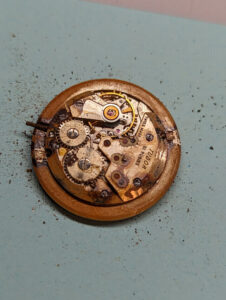We often see Tudor watches in our workshop. Tudor as a brand need no introduction – the brand is often uttered in the same breath as Rolex, and Tudor is likewise synonymous with high-quality, luxury timepieces. These watches are well worth maintaining and often become heirlooms passed down between generations. In this instance we have a vintage model in rather poor condition – a Tudor Oysterthin.
On initial assessment this watch was not functional. Removal of the case back opened a bit of a horror show, with the Tudor calibre 2402 manual wind movement showing significant water damage. Almost everything was damaged, with only a few components suitable for re-use. When a watch is so damaged, our options for repair are limited. We of course want to preserve as much of the original watch as possible, but a watch is also a functional item, so it needs to work correctly! We secured a vintage donor movement of the same calibre to use for parts – we did everything possible to preserve originality but parts like the water damaged wheels absolutely needed to be replaced.

The parts we were able to save from the original movement were thoroughly de-rusted and cleaned by hand, before going through a cycle in the watch movement cleaning machine. These were then checked after cleaning, before combining with the donor components for another round in the cleaning machine. After cleaning the movement is carefully reassembled and oiled, plus we fitted a new mainspring. A mainspring in excellent condition is crucial to ensure a properly functioning watch – the mainspring is the source of power for the movement after all. Once everything is back together we adjust and test the movement, before the dial and hands – which have been given a gentle clean but not a complete restoration, as per our clients request – are refitted and the watch is cased up.
For watches like this we recommend servicing every 3-5 years. This is to ensure optimal performance of the movement (as the oils and greases needed to keep the movement running properly need to be kept fresh) and to allow the movement to be checked for signs of wear and tear.
Yours sincerely
David Clark DGA PJDip PJGemDip CertGA
Managing Director
W.E. Clark & Son Limited
